Development of Integrated Flooding Early Warning and Rainfall Runoff Management Platform for Downtown Area of Shanghai
Abstract
:1. Introduction
2. Materials and Methods
2.1. Scope of Study
2.2. Data Collection
2.3. Management Platform Architecture
2.4. Selection of Modeling Software Platform
2.5. Methods for Development of the Management Platform
2.5.1. Development of the off-line drainage network model
2.5.2. Development of the Off-Line Drainage Network Model
2.5.3. Development of On-Line Real-Time early Warning and Forecasting System
2.5.4. Development of Web Client Real-Time Publishing System for the Real-Time Model System
3. Results and Discussion
3.1. Major Design Features of the Management Platform
3.2. Operating Mechanism Design of the Management Platform
3.3. Application Performance of the Management Platform
4. Conclusions
Author Contributions
Funding
Institutional Review Board Statement
Informed Consent Statement
Conflicts of Interest
References
- Song, X.; Zhang, J.; Zou, X.; Zhang, C.; AghaKouchak, A.; Kong, F. Changes in precipitation extremes in the Beijing metropolitan area during 1960–2012. Atmos. Res. 2019, 222, 134–153. [Google Scholar] [CrossRef]
- Tezuka, S.; Takiguchi, H.; Kazama, S.; Sato, A.; Kawagoe, S.; Sarukkalige, R. Estimation of the effects of climate change on flood-triggered economic losses in Japan. Int. J. Disaster Risk Reduct. 2014, 9, 58–67. [Google Scholar] [CrossRef]
- Pitt, M. Learning Lessons from the 2007 Floods; An Independent Review by Sir Michael Pitt: London, UK, 2008. [Google Scholar]
- Greenough, G.; McGeehin, M.; Bernard, S.M.; Trtanj, J.; Riad, J.; Engelberg, D. The Potential Impacts of Climate Variability and Change on Health Impacts of Extreme Weather Events in the United States. Environ. Health Perspect. 2001, 109, 191–198. [Google Scholar] [CrossRef] [PubMed] [Green Version]
- Shidawara, M. Flood hazard map distribution. Urban Water 1999, 1, 125–129. [Google Scholar] [CrossRef]
- Zhang, L.P.; Wei, Y.M.; Fan, Y. Information Management System of Vulnerability for Evaluation of Flood Disaster. J. Nat. Disasters 2002, 11, 66–73. [Google Scholar] [CrossRef]
- Li, J.; Ding, R.Z.X.; Huang, S.F.; Hu, Y.L. Research of Flood and Waterlogging Loss Assessment Model Based on Spatial Distribution Soical Economic Database. J. China Inst. Water Resour. Hydropower Res. 2003, 2, 104–110. [Google Scholar] [CrossRef]
- Ren-Jun, Z. The Xinanjiang model applied in China. J. Hydrol. 1992, 135, 371–381. [Google Scholar] [CrossRef]
- Liu, C.; Guo, L.; Ye, L.; Zhang, S.; Zhao, Y.; Song, T. A review of advances in China’s flash flood early-warning system. Nat. Hazards 2018, 92, 619–634. [Google Scholar] [CrossRef] [Green Version]
- Zhang, D.-W.; Quan, J.; Zhang, H.-B.; Wang, F.; Wang, H.; He, X.-Y. Flash flood hazard mapping: A pilot case study in Xiapu River Basin, China. Water Sci. Eng. 2015, 8, 195–204. [Google Scholar] [CrossRef] [Green Version]
- Gong, Y.W.; Qi, H.J.; Song, R.N.; Li, J.Q. Error Analysis in Simulation of Urban Stormwater Runoff Using Default Parameters. China Water Wastewater 2012, 28, 46–50. [Google Scholar] [CrossRef]
- Jiang, M. Study of Shanghai Design Rainstorm Profile under the New Rainstorm Situation. J. Hunan Inst. Sci. Technol. Nat. Sci. 2015, 28, 69–80. [Google Scholar] [CrossRef]
- Standard of Rainstorm Intensity Formula and Design Rainstorm Distribution (DB31/T 1043 2017); Shanghai Municipal Bureau of Quality and Technical Supervision: Shanghai, China.
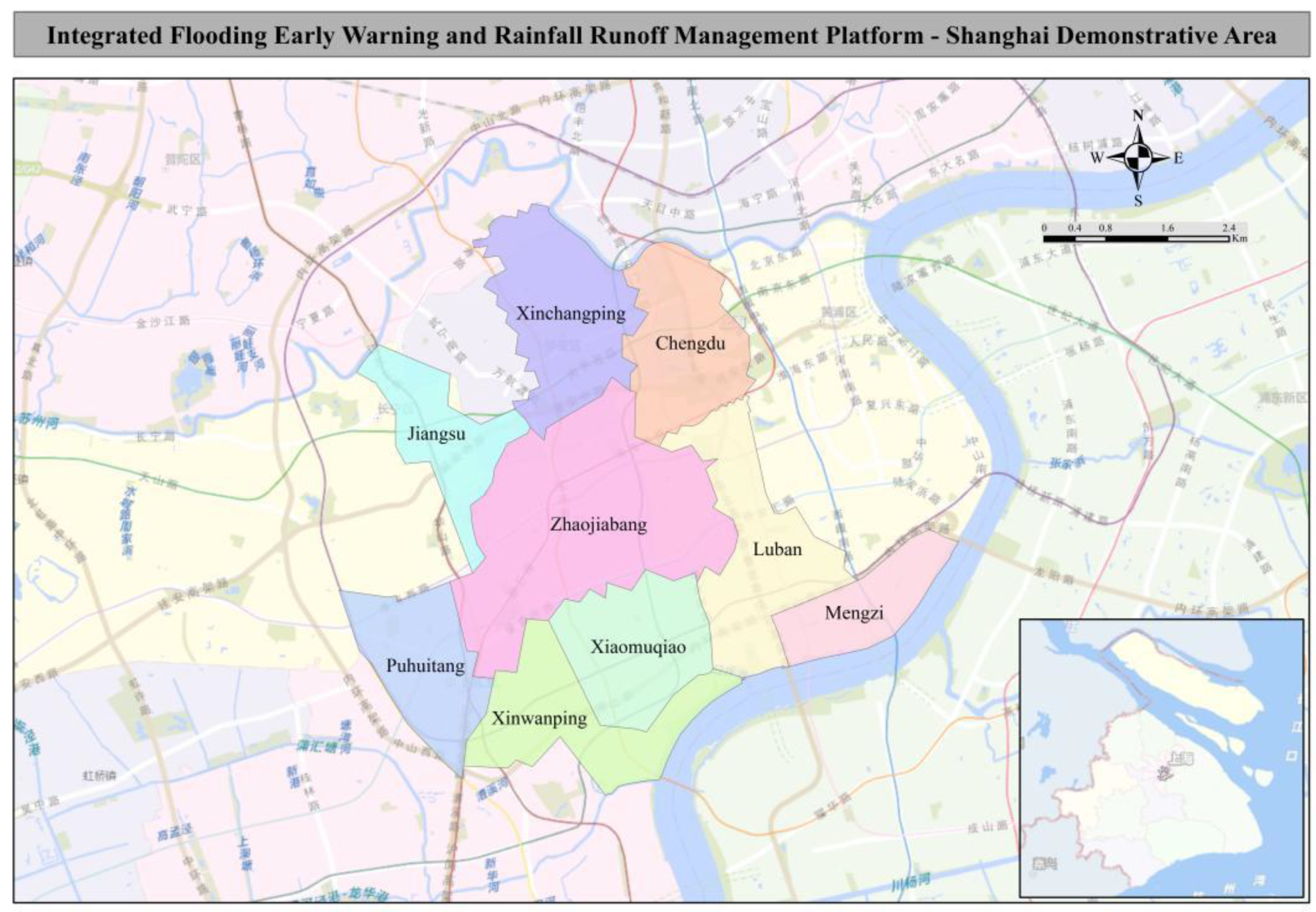
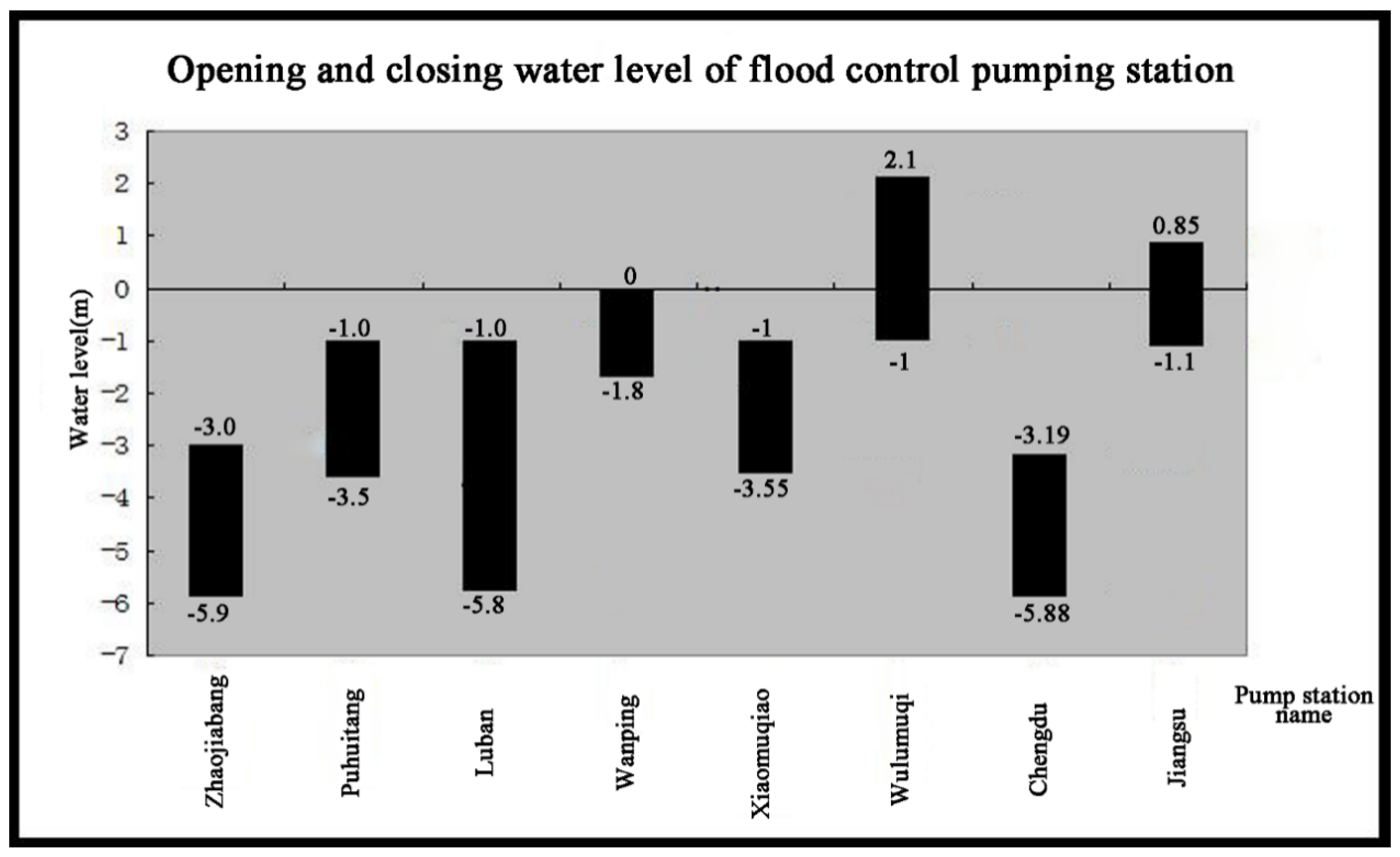
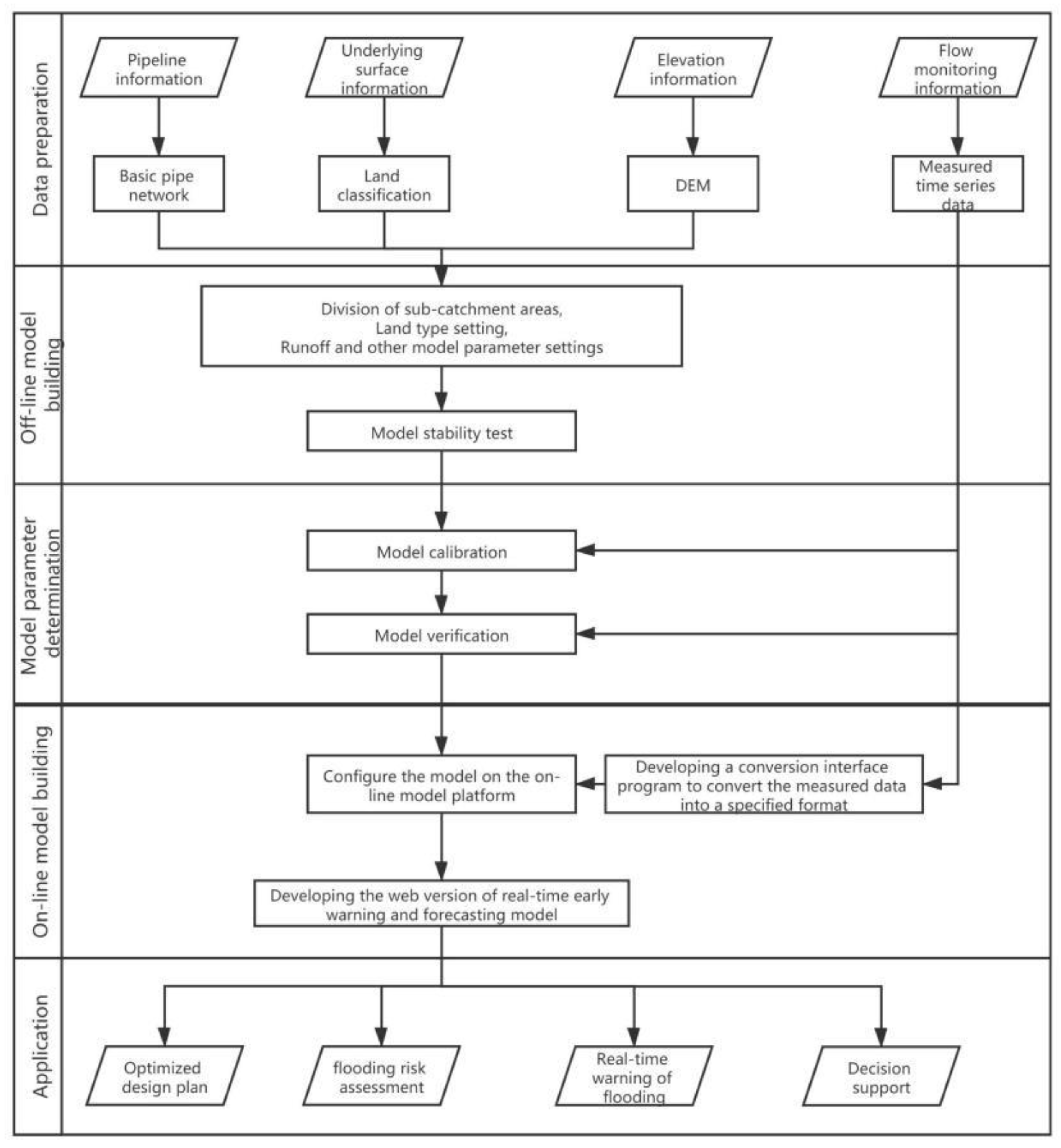
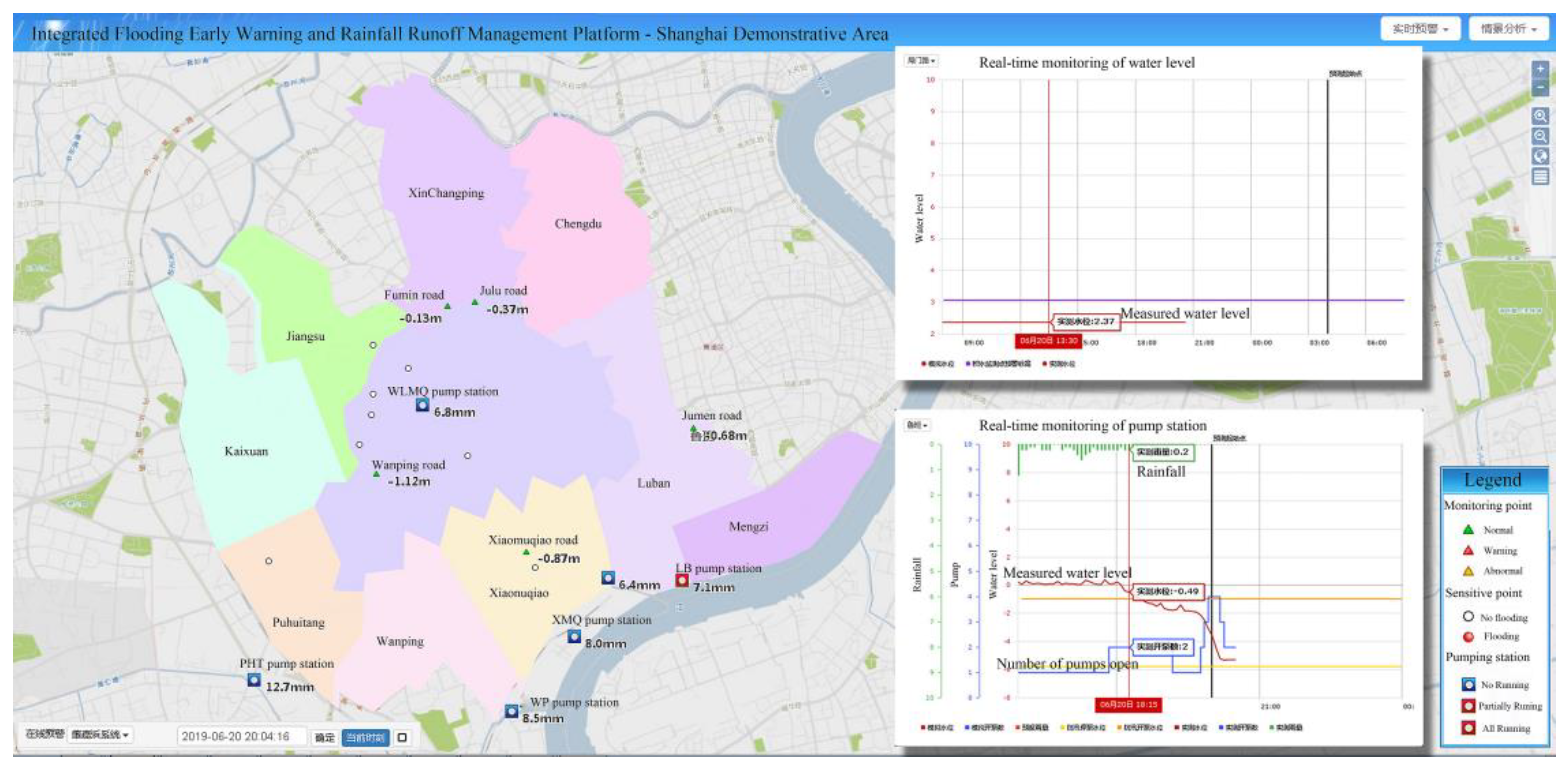
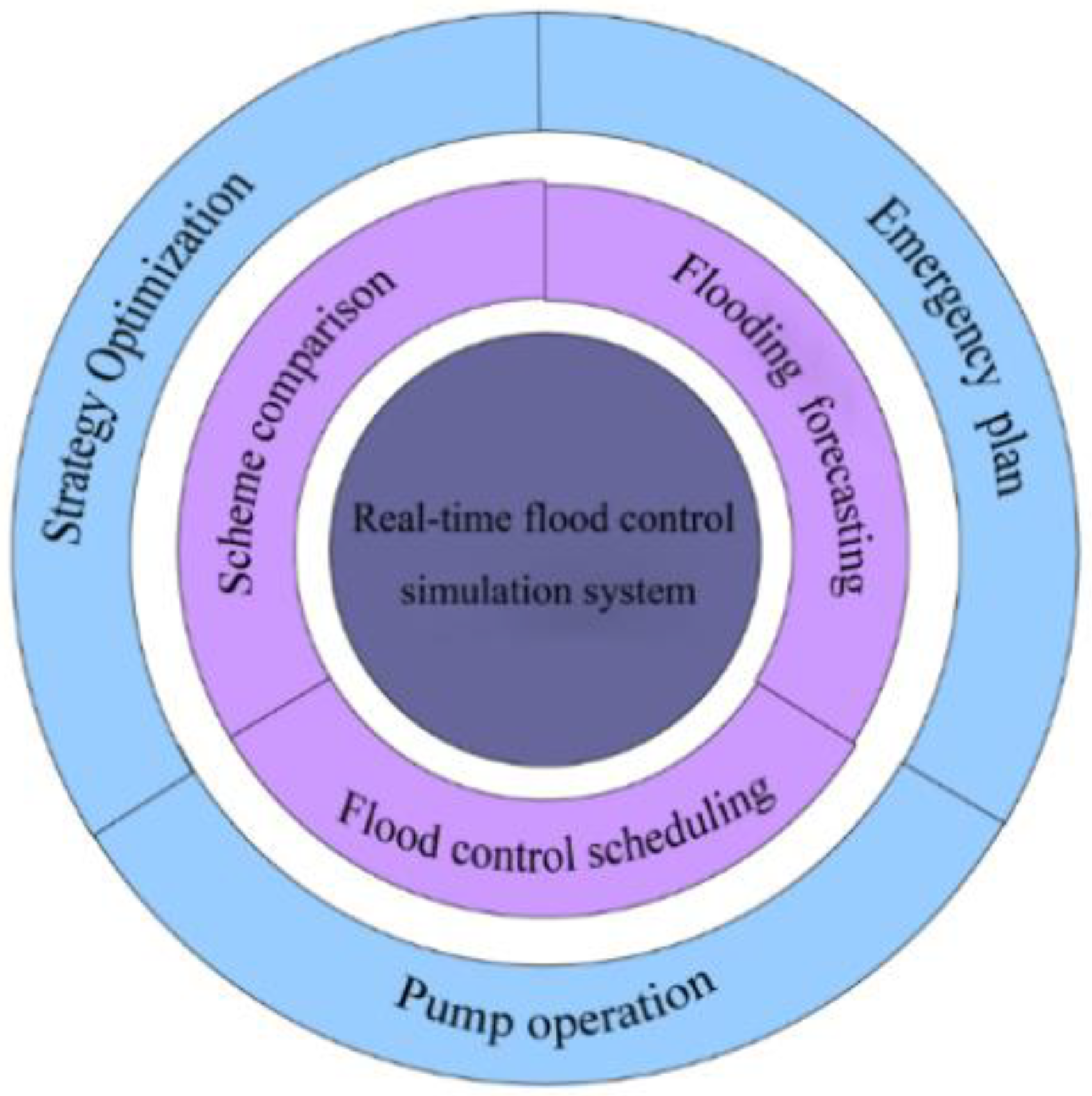
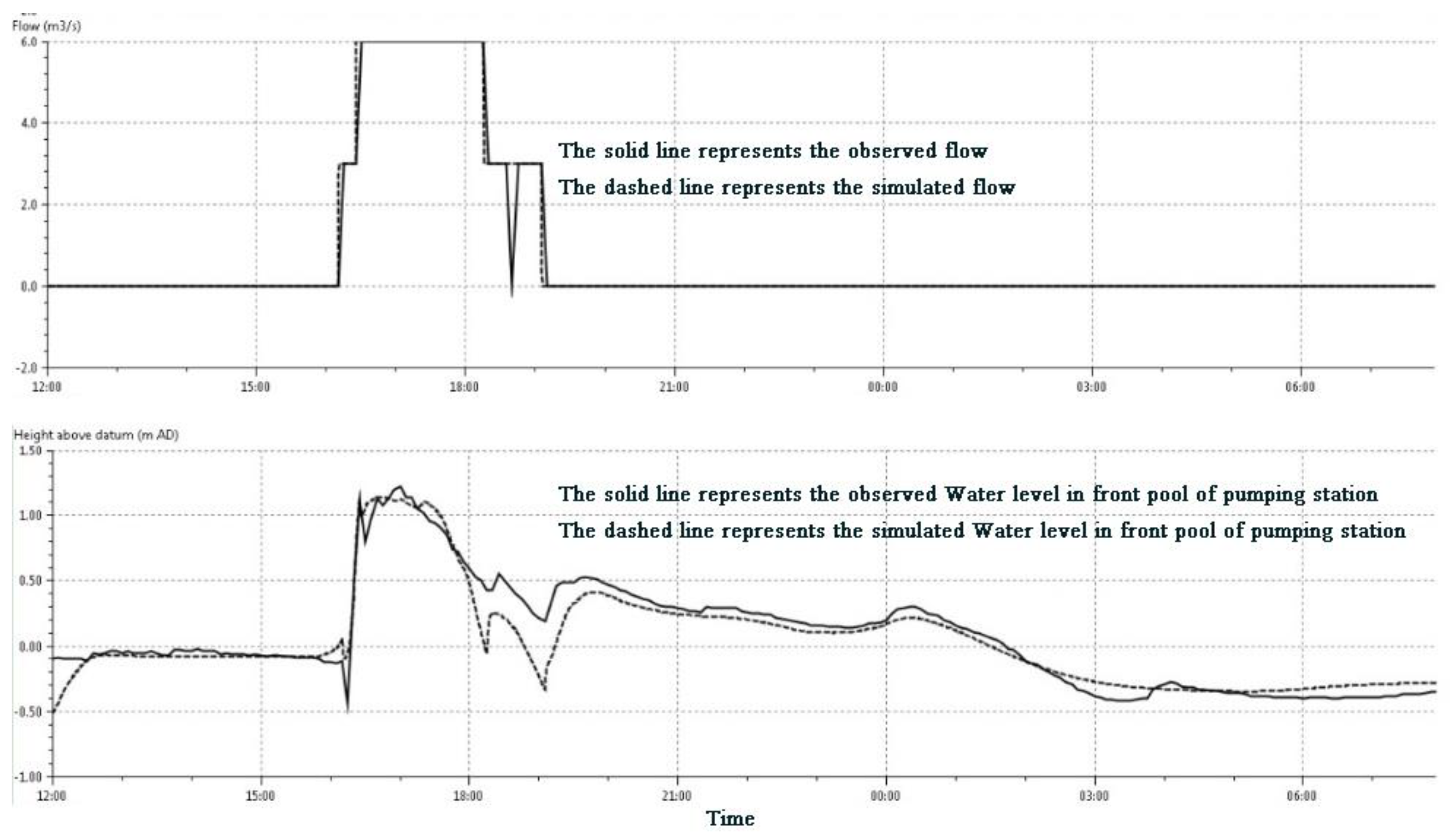
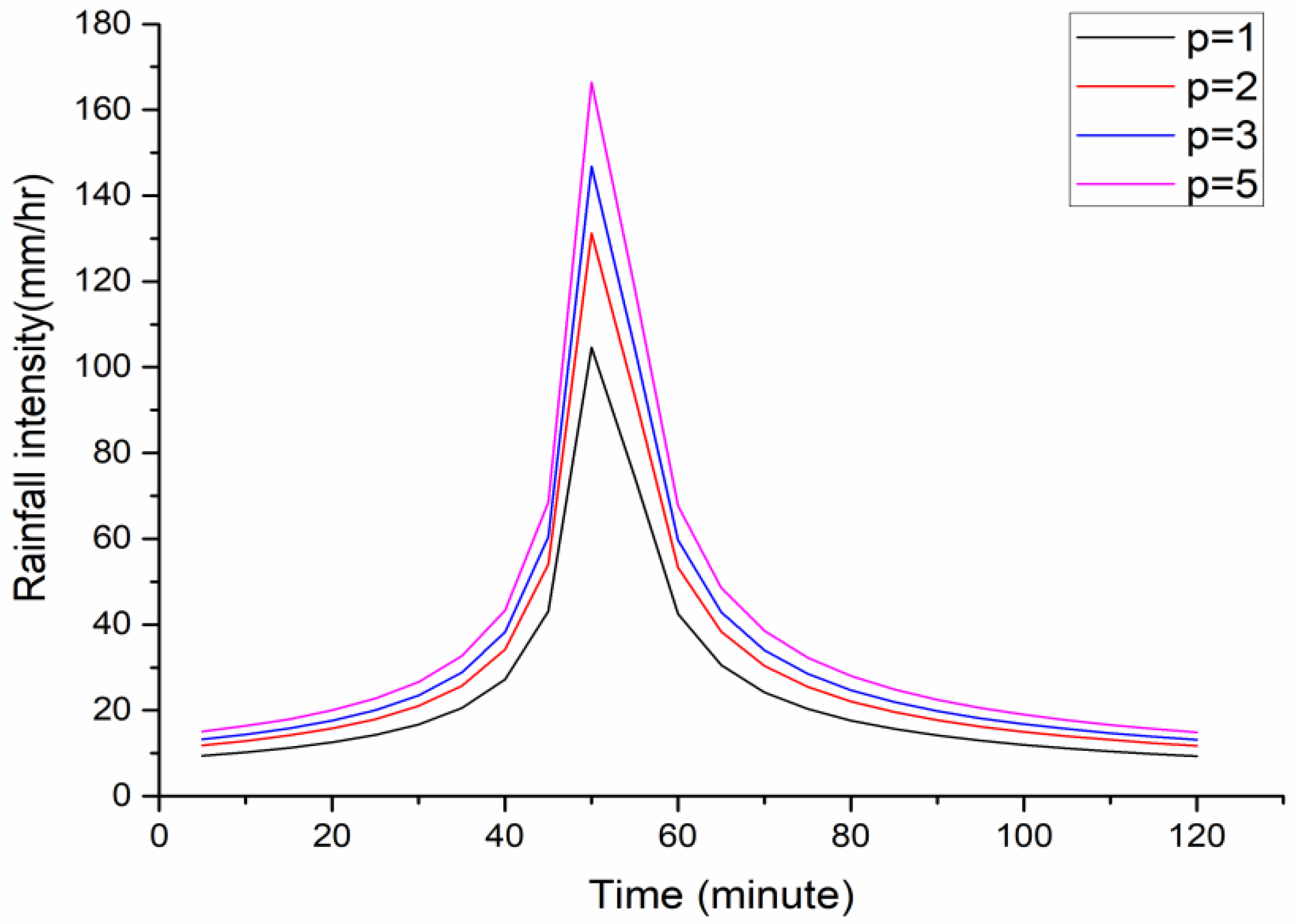
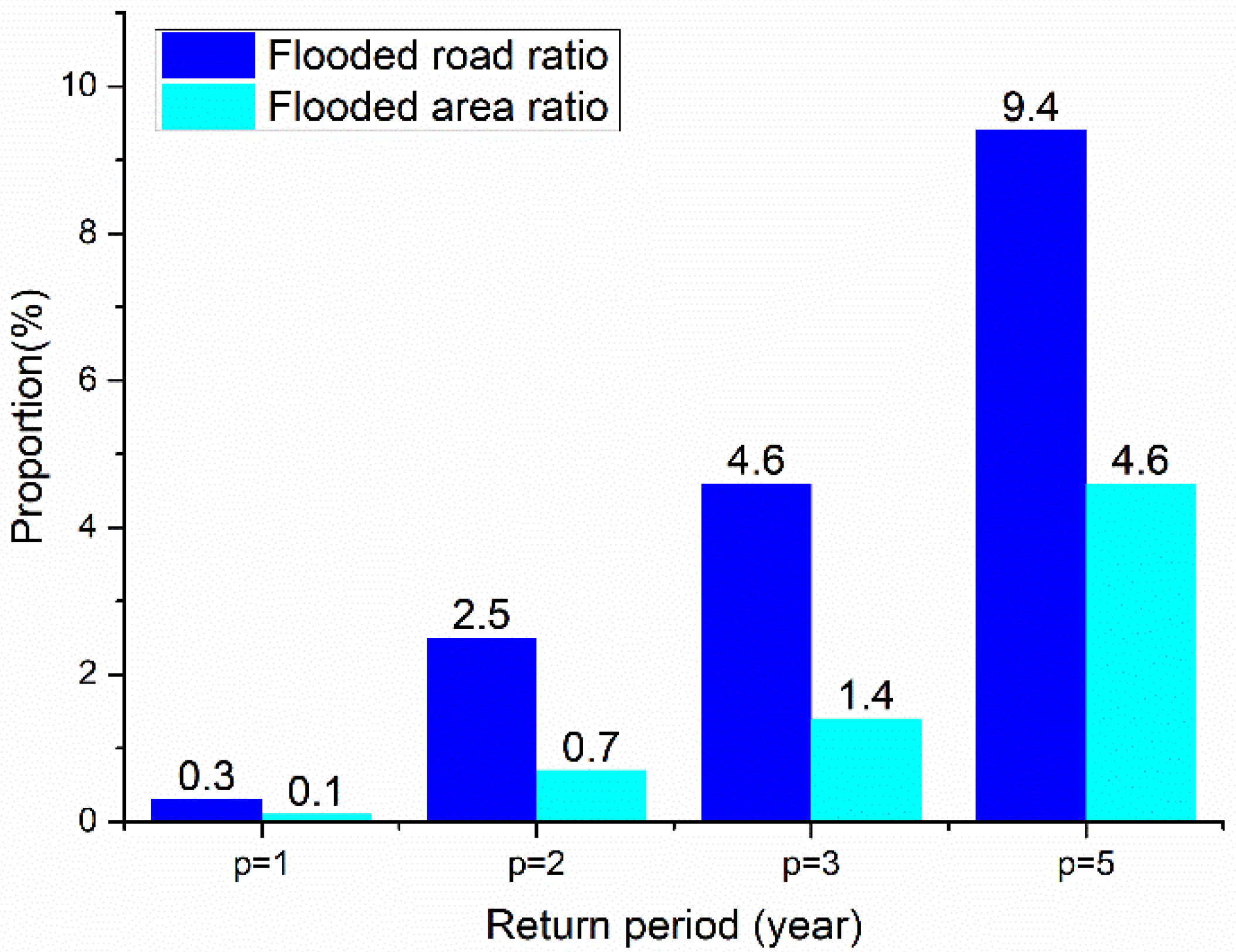
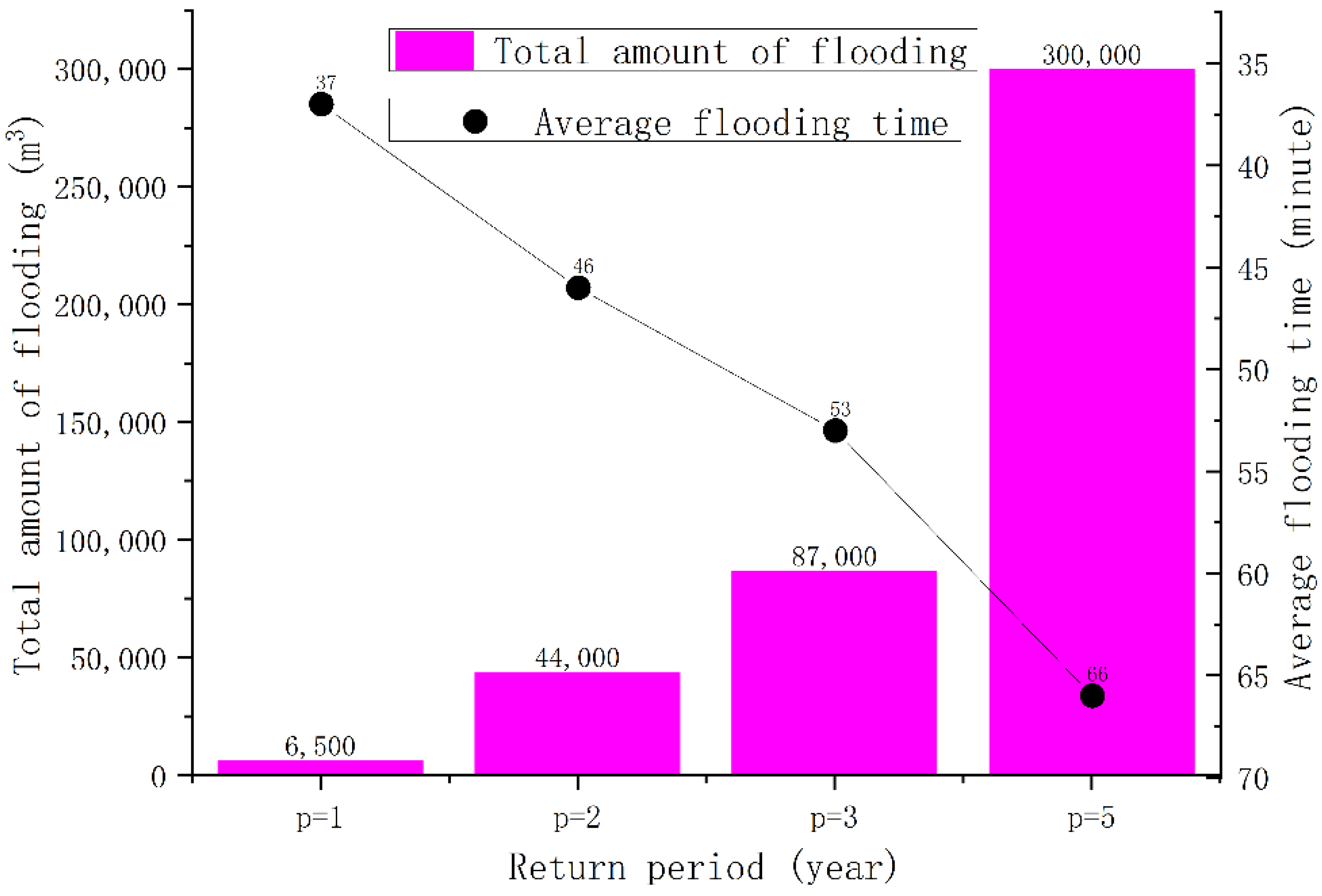
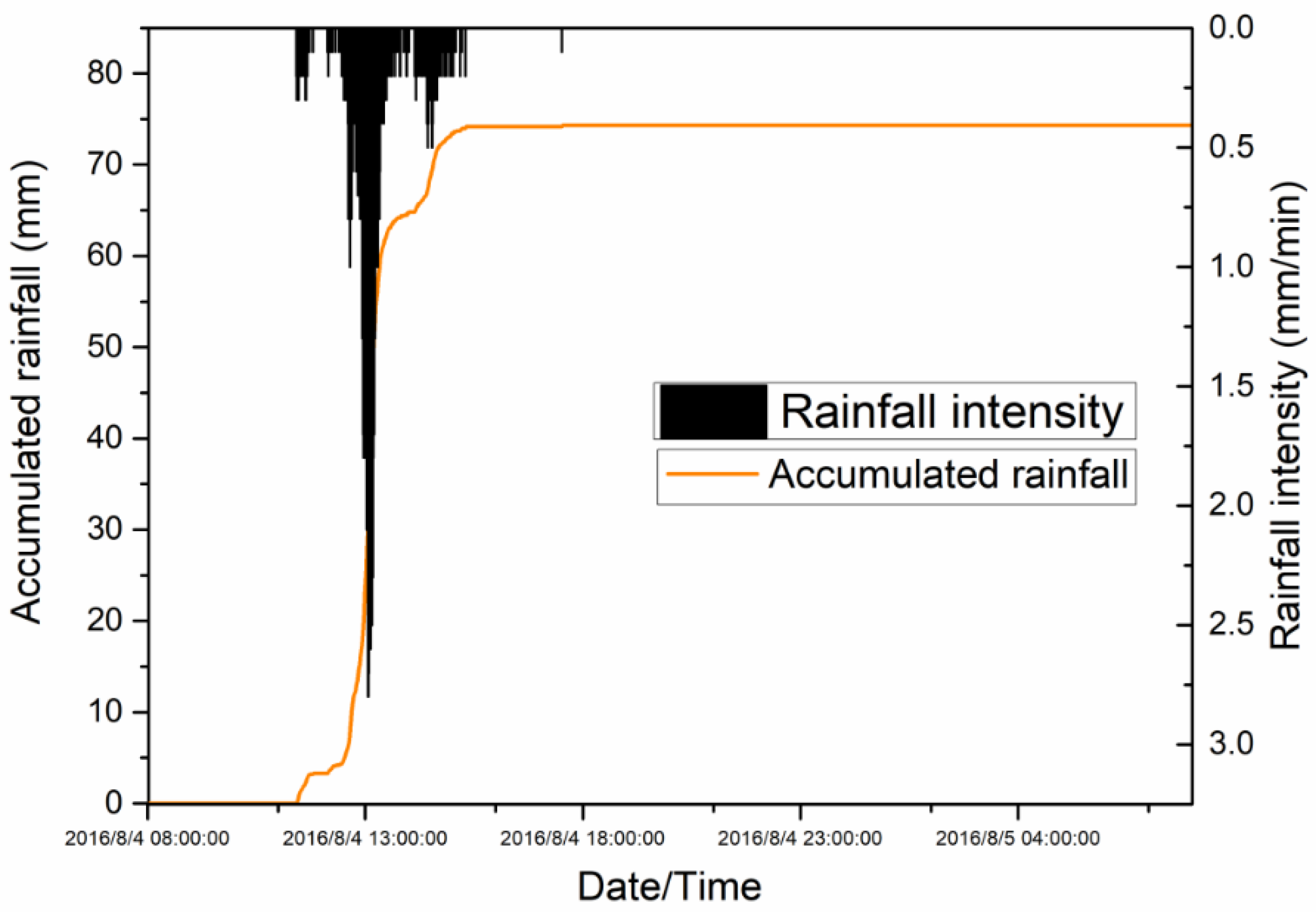
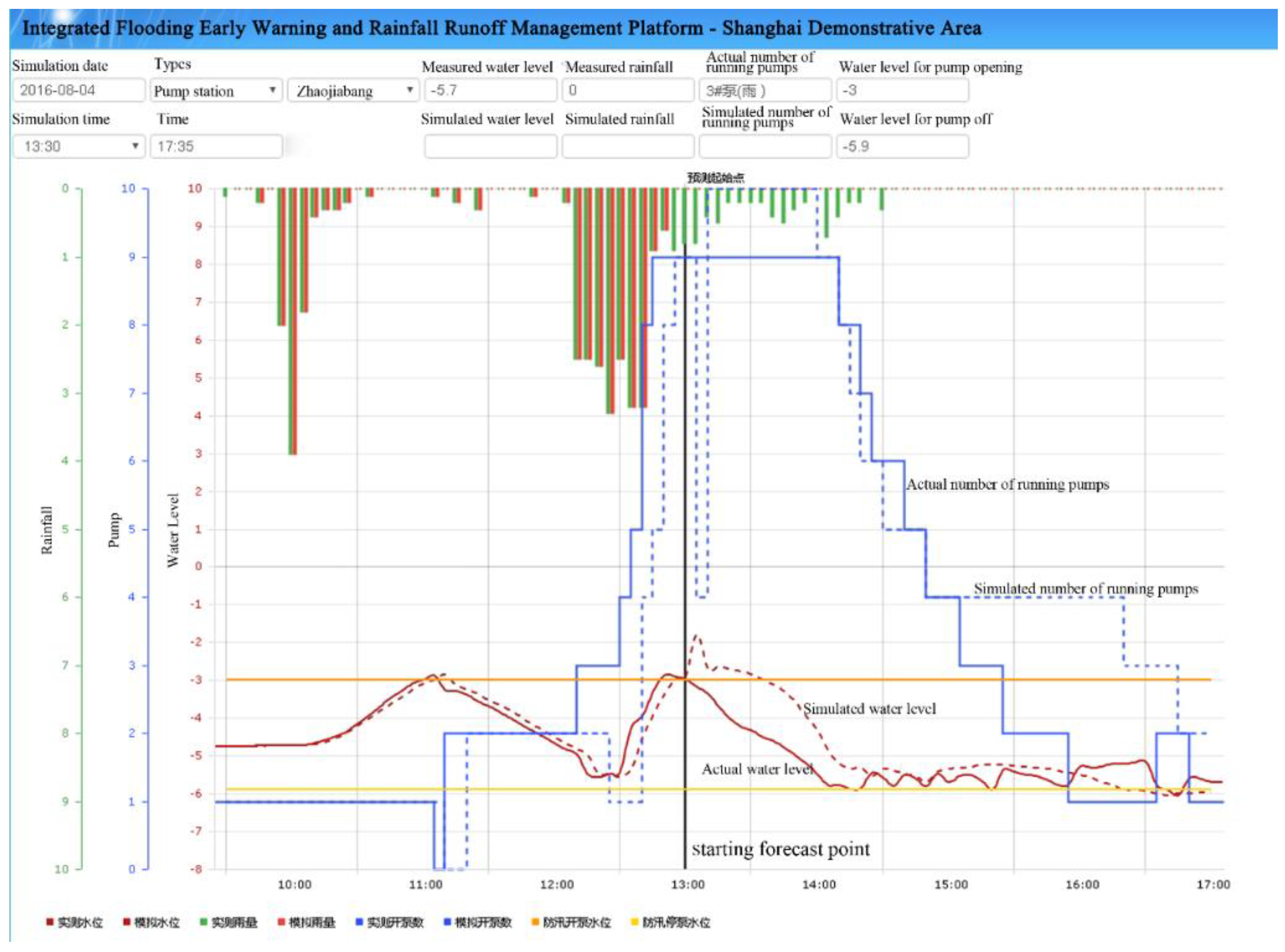
| No. | Date | Accumulated Rainfall (mm) | Maximum Hourly Precipitation (mm/h) |
|---|---|---|---|
| 1 | 3 July 2010 | 78.7–115.3 | 28.1–40.6 |
| 2 | 17 August 2010 | 9.5–65.5 | 9.1–55.2 |
| 3 | 25 August 2010 | 12.7–91.5 | 5.6–43.9 |
| 4 | 1 September 2010 | 58.4–148.6 | 22.4–56.2 |
| 5 | 13 September 2013 | 26.9–115.6 | 21.6–88 |
| 6 | 7–9 October 2013 (Typhoon Fitow) | 145.7–224.1 | 14.6–24 |
| 7 | 17 June 2015 | 131.6–231.0 | 14.4–50.1 |
| No. | Item | Format | Major Content |
|---|---|---|---|
| 1 | Planning layout, design drawing, as-built drawing | CAD file, images | Construction data of drainage system and supporting facilities |
| 2 | Inspection shaft | Shape file | Location, elevation |
| 3 | Pipeline | Shape file | Location, pipe diameter, elevation |
| 4 | Supporting facilities including pump station, etc. | Shape file, images | Location, pump capacity, number of pumps, head of delivery chart |
| 5 | Pump station scheduling rules | Documents | Water pump on/off water level |
| No. | Item | System Category | Service Area (km2) | Comprehensive Design Runoff Coefficiency | Current Discharge Standard | Current Pump Station Name | Current Flow | Planning Flow | Interception Capacity | Receiving Water Body |
|---|---|---|---|---|---|---|---|---|---|---|
| m3/s | m3/s | m3/s | ||||||||
| 1 | Zhaojiabang | Combined system | 7.38 | 0.67 | 1 | Zhaojiabang | 29.43 | 34.2 | 4.8 | Huangpu River |
| 2 | Puhuitang | Combined system | 2.6 | 0.7 | 1 | Puhuitang | 16.98 | 16.98 | 1.52 | Puhuitang |
| 3 | Luban | Combined system | 3.6 | 0.8 | 1 | Luban | 25.6 | 31 | 5.41 | Huangpu River |
| 4 | Xiaomuqiao | Combined system | 2.93 | 0.6 | 1 | Xiaomuqiao | 18 | 18 | 1.92 | Huangpu River |
| 5 | Xinwanping | Combined system | 3.13 | 0.6 | 1 | Xinwanping | 9.2 | 17.2 | 1.11 | Longhua habour |
| 6 | Jiangsu | Combined system | 2.18 | 0.69 | 1 | Jiangsu | 12.9 | 12.9 | 4.8 | Suzhou River |
| 7 | Chengdu | Combined system | 3.03 | 0.71 | 1 | Chengdu | 22.495 | 25.8 | 3.3 | Suzhou River |
| 8 | Xinchangping | Combined system | 3.66 | 0.7 | 1 | Xinchangping | 19.98 | 22 | 3.01 | Suzhou River |
| 9 | Shibomengzi | Seprate system | 1.88 | 0.6 | 5 | Mengzi | 16.8 | 16.8 | 0.36 | Huangpu River |
| No. | Item | Format | Major Content |
|---|---|---|---|
| 1 | SCADA log of drainage pump station | Database, CSV, txt files, etc. based on interval of 1–5 min | Field rainfall measurements, intake structure water level, pump on/off status of the 9 drainage pump stations within the research area |
| 2 | Flooding monitoring point SCADA log | Database, CSV, txt files, etc. based on interval of 1–5 min | Field water depth measurements of 3–5 flooding monitoring points within the research area |
| 3 | Drainage pipeline CCTV detection report | Txt files | Functionality and structure defective results of drainage pipelines detected by CCTV |
Publisher’s Note: MDPI stays neutral with regard to jurisdictional claims in published maps and institutional affiliations. |
© 2021 by the authors. Licensee MDPI, Basel, Switzerland. This article is an open access article distributed under the terms and conditions of the Creative Commons Attribution (CC BY) license (https://creativecommons.org/licenses/by/4.0/).
Share and Cite
Shi, Z.; Shen, Q.; Tan, Q.; Li, T. Development of Integrated Flooding Early Warning and Rainfall Runoff Management Platform for Downtown Area of Shanghai. Sustainability 2021, 13, 11250. https://doi.org/10.3390/su132011250
Shi Z, Shen Q, Tan Q, Li T. Development of Integrated Flooding Early Warning and Rainfall Runoff Management Platform for Downtown Area of Shanghai. Sustainability. 2021; 13(20):11250. https://doi.org/10.3390/su132011250
Chicago/Turabian StyleShi, Zhenbao, Qingran Shen, Qiong Tan, and Tian Li. 2021. "Development of Integrated Flooding Early Warning and Rainfall Runoff Management Platform for Downtown Area of Shanghai" Sustainability 13, no. 20: 11250. https://doi.org/10.3390/su132011250
APA StyleShi, Z., Shen, Q., Tan, Q., & Li, T. (2021). Development of Integrated Flooding Early Warning and Rainfall Runoff Management Platform for Downtown Area of Shanghai. Sustainability, 13(20), 11250. https://doi.org/10.3390/su132011250





